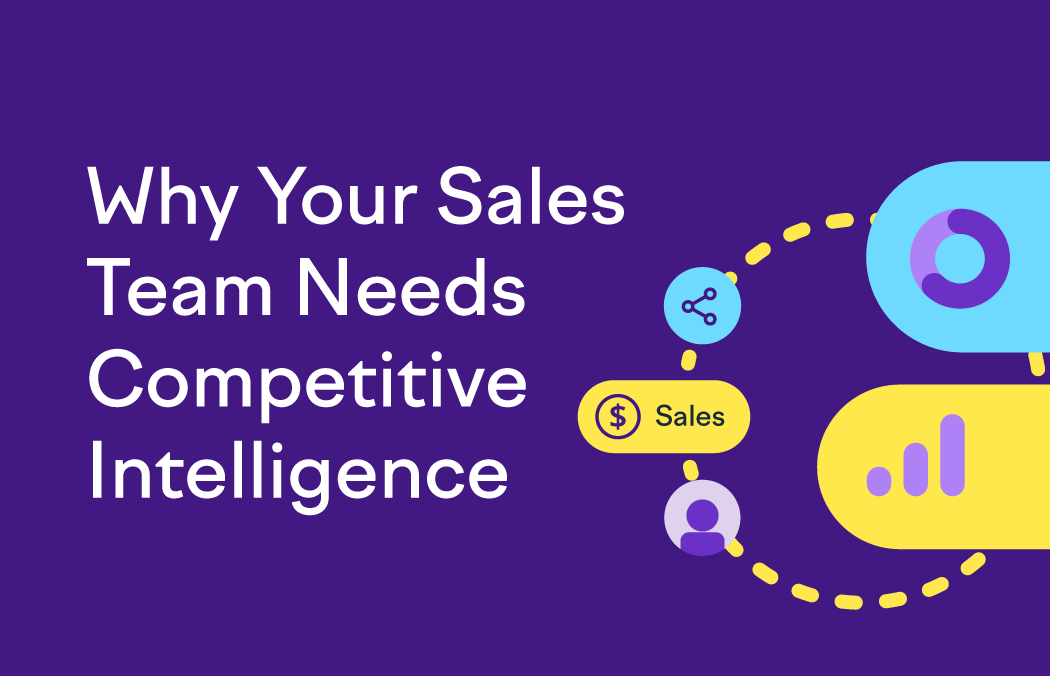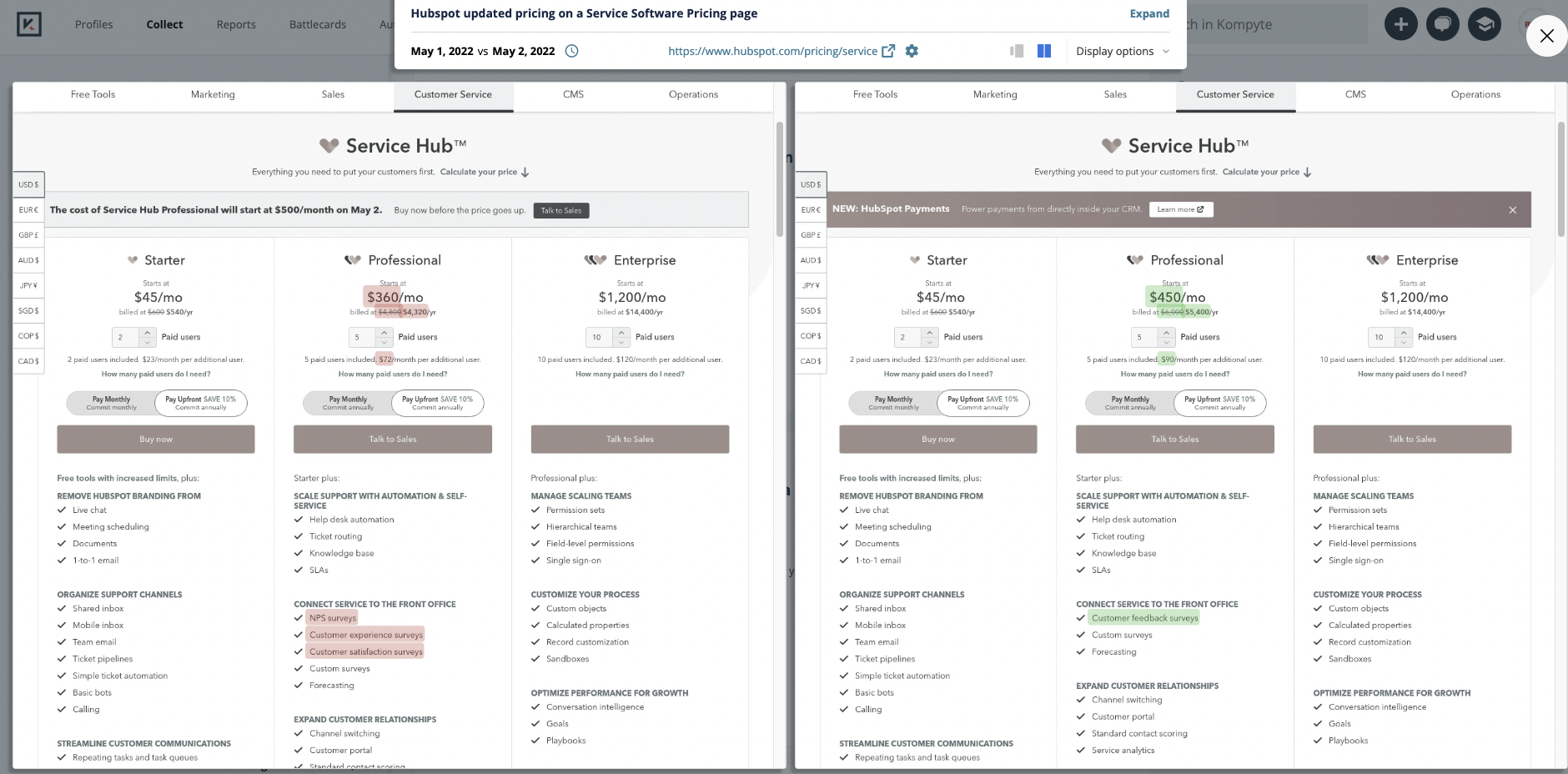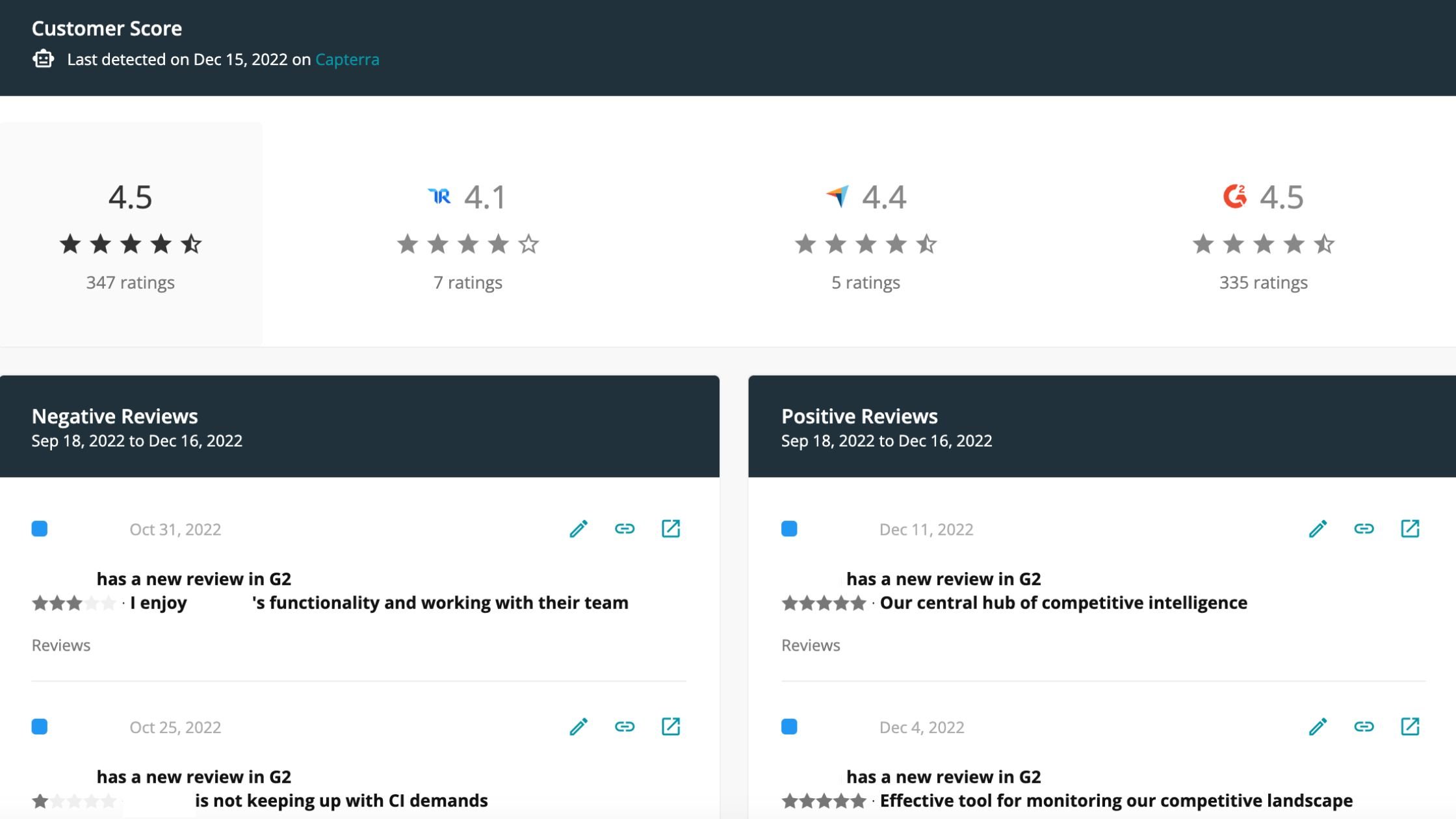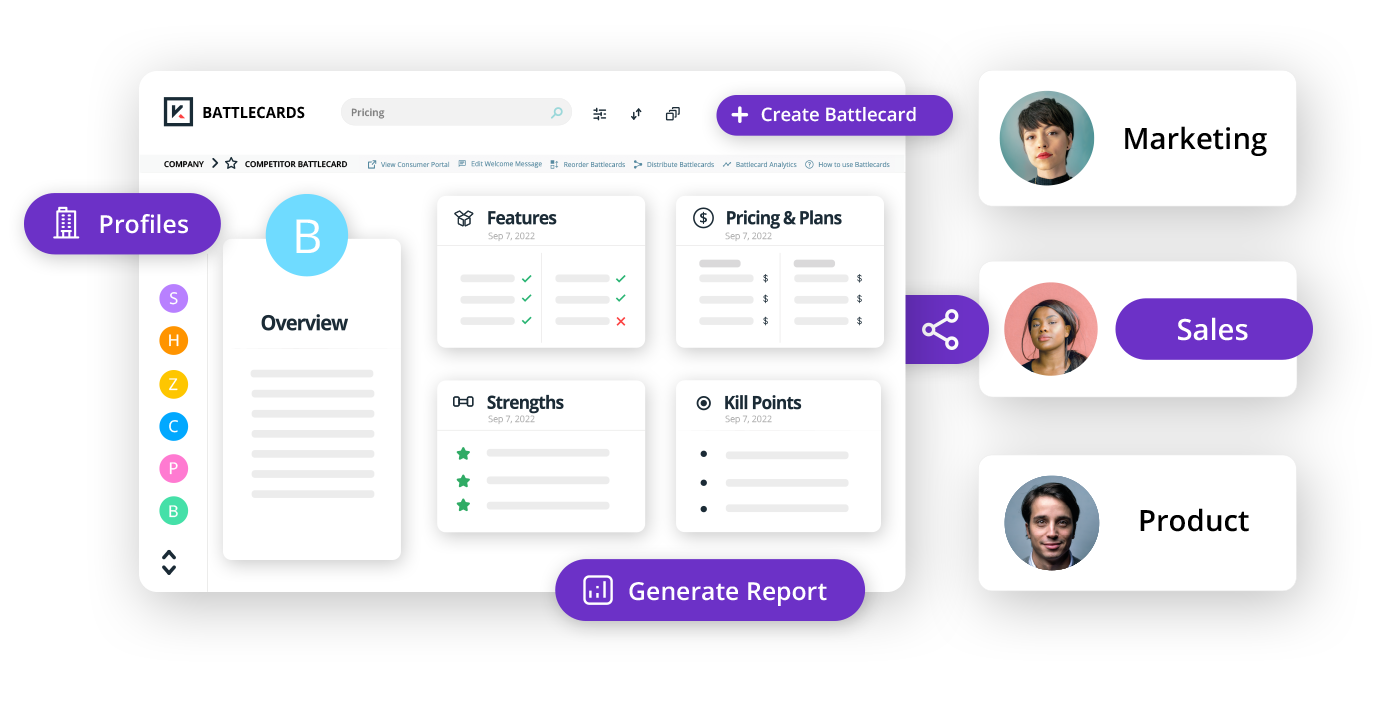5 Future Marketing Trends to Look Out For with Competitive Intelligence
The business world is in a constant state of evolution, even the competitive intelligence (CI) industry is in a continual state of flux. Find out...
Competitive intelligence enables a sales team to highlight the unique strengths of their products, overcome objections, anticipate tough questions, and close more deals.

The short answer? Your sales team needs competitive intelligence because without it, you're losing deals you should be winning. In fact, a study of Kompyte users revealed that those who began using Battlecards (a typical format for sharing competitive intelligence) saw an increase in win rate of up to 30%.
Competitive intelligence is the process of gathering, analyzing, and disseminating information about competitors with a view to providing a business with insights that are then used to make informed decisions, identify opportunities and threats, and develop sales and marketing strategies with a view to gaining a competitive advantage.
Competitive intelligence professionals, product marketing managers, and sales enablement specialists use a variety of tools and techniques, such as market research, industry analysis, and competitive analysis, to gather and analyze this information and then share it with the sales team to help them overcome objections and increase sales.
Competitive intelligence can help a sales team close more deals, faster. Armed with insights about up-to-date changes in product offerings, messaging, or price changes, a salesperson has a clear view of their place in the competitive landscape. This allows them to highlight the unique strengths of their products and overcome objections, anticipate tough questions and use effective responses which are always at their fingertips.
In contrast, a lack of competitive intelligence leaves a sales team ill equipped to make a good case for why their product or service is better for a given customer than what the competition offers and can leave them scrambling to find answers and overcome deal-busting objections.
FOMO isn’t just an issue for tweens on social media - sales teams need to feel confident that they have the latest competitor intelligence at all times in order to speak with assurance and in a way that inspires trust with prospective customers. No one wants to be caught off guard in the middle of a sales call. “Competitor X just added this new integration? Uhhh, right, I knew that….” It’s not a good look.

Here the Kompyte dashboard alerts us to a change on a competitor’s product features page.
The insights you gather with competitive intelligence might include any of the following:
Information about a competitor's products and services including:
Information about customer needs and preferences, including insights from customer feedback as available on review sites.

Kompyte monitors key pages for you, alerting you to changes in competitor pricing.
For example, if a sales team has access to competitive intelligence about the features offered by its competitors, it can use this information to better understand the value proposition of its own products and how they compare to those of its competitors. This can help the sales team tailor its sales pitch to better address the needs and concerns of potential customers, and highlight the unique benefits of its products.
In addition, competitive intelligence can help sales teams stay up-to-date on industry trends and changes, which can be valuable in identifying new opportunities for sales. For example, if a sales team becomes aware of a new product or service offering from a competitor, it can use this information to anticipate customer needs and develop strategies to address them. They can also let the product team know so they can evaluate the feature for possible development.
Competitive intelligence can help sales teams tailor their sales pitch to better address the needs and concerns of potential customers and even to speak to them using their own words to powerful effect.
For example, if a sales team knows the weaknesses of their competitors’ products, it can use this information to highlight the strengths of its own products and address any potential concerns that customers may have.
Keeping up with customer reviews left on various sites can help sales teams better understand what customers like and dislike about their products and that of their competitors, allowing them to play up their strengths, and contrasting them with the weaknesses in competitor products, even using actual phrases from reviews, such as, “Our users appreciate how easy it is to use our dashboard without any learning curve.” You don’t have to call out your competitors directly for this to be highly effective!

Kompyte surfaces new competitor reviews in your sales Battlecards.
Reviews like this might move you to stress the speed, reliability, and price stability of your product.
Competitive enablement refers to the process of putting everything learned through the competitive intelligence program into the assets, training, and support a sales team needs in order to be successful.
Beyond basic “sales 101” training, competitive enablement is an ongoing process focused on equipping salespeople to effectively engage with potential customers, identify and address their needs, and differentiate their own products and services from those of their competitors.
The responsibility to enable a sales team may fall on a sales leader, a product marketing manager, competitive intelligence expert, or sales enablement professional who must collect insights in real time, filter and analyze these insights, and then disseminate their findings to everyone on the sales team.
.jpg?width=2240&height=250&name=what%20is%20sales%20enablement%20(2).jpg)
First, figure out what information you need. You might start by meeting with your sales team to find out which objections come up often, where they get “stuck” on sales calls, and where they feel less than confident in their sales scripts.
Once you know what information you need, it’s time to determine where to find it. Make a list of URLs for publicly-available sources such as:
Once you start to collect the information, you’ll need somewhere to keep it! You could use Airtable or a spreadsheet to track every URL and the insights gathered there over time. Or try a template specifically designed to guide you through a competitive analysis.
While competitive intelligence can be used to inform stronger product roadmaps and enable better go-to-market strategies among other things, what you share with your sales team will be limited to only those insights that help them sell.
When you create your spreadsheet or airtable, make sure you create a filter view just for sales. Better yet, use competitive intelligence automation that keeps everything up to date and in one central location such as a report, feed, or Battlecard. See how it could work for your business.
Your hard work is only useful when it’s available to everyone in a way that is easy to understand and use on a sales call.
Initially and on a regular basis, meeting to discuss recent findings can be an effective way to ensure everyone is reasonably on the same page. But if you can make sales enablement assets like reports and Battlecards (a quick “cheat sheet” outlining a competitor’s products, strengths, and weaknesses) available and easy to find, you’ll have a much better chance of increasing adoption across the team.
Everything your sales team needs to quickly overcome objections, present your product well, and win more deals. For each competitor, you may want to include:

Competitive intelligence changes constantly. And nothing undermines the confidence of the sales team in your hard-won competitive intelligence program like being caught off guard in a sales call because their Battlecards or other reports didn’t include a crucial update.
Set up alerts: Use tools like Google Alerts or Mention to set up alerts for keywords or phrases related to your competitors, customers, or industry. This can help you stay informed about new developments and updates as they happen.
Monitor social media: Follow your competitors, customers, and industry thought leaders on social media to stay up-to-date on their activities and thoughts.
Attend industry events and conferences: Attend industry events and conferences to learn about new developments and trends, and to network with other professionals in your field.
Keep an eye on the news: Stay informed about industry news by subscribing to relevant publications and following relevant news sources online.
If this sounds like a lot of work that will require a lot of time, you’re right. It will. Which is why many companies who rely on competitive intelligence to reach their sales targets use competitive intelligence automation. In about an hour a week, your sales team can always have up-to-date intelligence.

Competitive intelligence is essential for sales teams to achieve success in a competitive marketplace. When they have up-to-date insights and knowledge about competitors, customers, and industry trends, they can close more deals as they identify new opportunities, develop more effective sales strategies, and differentiate their products and services from those of their competitors.
By investing in competitive intelligence, sales teams gain a valuable competitive advantage and drive success for their organization.
If you'd like to see how competitive intelligence automation could work for your team, you can book a demo here.
The business world is in a constant state of evolution, even the competitive intelligence (CI) industry is in a continual state of flux. Find out...
In business, it is clear that there are certain initiatives that technology excels at aiding, and does better than humans can. For these types of...
Do you know how to respond to business threats? Find out how to proactively turn those threats into opportunities with this 5-step plan.
Be the first to know about new B2B SaaS Marketing insights to build or refine your marketing function with the tools and knowledge of today’s industry.